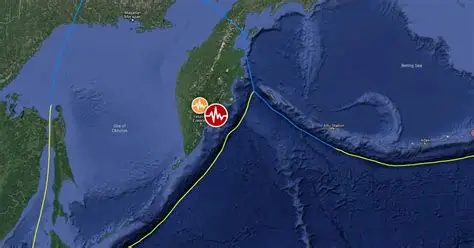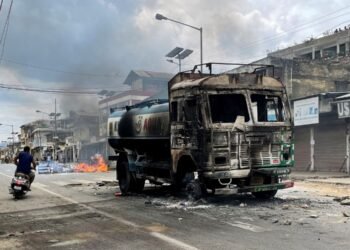The Pacific Rim was on high alert Wednesday after a megaquake shook Kamchatka, prompting tsunami warnings across half the globe. Though no fatalities have been confirmed, authorities brace for more waves and structural damage.
BY PC Bureau
July 30, 2025: A colossal magnitude 8.8 earthquake struck the Kamchatka Peninsula in Russia’s Far East early Wednesday, making it one of the strongest seismic events recorded globally since the catastrophic 2011 Japan earthquake. The tremor triggered widespread tsunami alerts across the northern Pacific Ocean, prompting emergency evacuations and flood warnings from Russia and Japan to as far as Hawaii, Alaska, and even New Zealand.
The quake struck offshore at a depth of approximately 29 kilometers beneath the Kuril-Kamchatka Trench, an active subduction zone where the Pacific Plate dives beneath the North American Plate. It was the strongest earthquake in the region since 1952, when a similar megathrust quake led to destructive tsunamis across the Pacific basin.
As the ground shook violently across eastern Russia, tsunami sirens began wailing in towns like Petropavlovsk-Kamchatsky and North Kurilsk. In the latter, a tsunami wave measuring approximately 1.5 meters (5 feet) inundated parts of the town and flooded a local fishing facility. Eyewitnesses reported seawater surging into homes and marketplaces, scattering fishing gear and overturning vehicles.
Emergency services rushed to evacuate thousands of residents from vulnerable coastal settlements. Authorities in Kamchatka described the operation as one of the largest regional evacuations in recent memory.
“People were running toward higher ground in darkness, bundled in coats, many without belongings,” said Elena Morozova, a schoolteacher in Ust-Kamchatsk. “The only sound louder than the sirens was the fear in the air.”
Shockwaves Across the Pacific
The quake’s impact was not limited to Russia. Tsunami watches and warnings were issued across Japan, Hawaii, Alaska, the U.S. West Coast, and even parts of Oceania.
In Hawaii, officials confirmed that Kahului Harbor in Maui saw tsunami surges of up to 4 feet, prompting evacuation orders and a temporary closure of airports, schools, and government buildings. Governor Josh Green declared a state of emergency, and National Guard units were deployed to assist with coastal surveillance and rescue.
“We narrowly avoided catastrophe,” said Gov. Green in a press briefing. “The waves were not as high as feared, but the speed and force were enough to damage infrastructure and scatter debris across roads and beaches.”
READ: Manipur: Another Hill District Up in Arms Over Absent DC
In Alaska, particularly along the Aleutian chain, coastal villages were evacuated as tsunami waves rolled toward the shore. Though smaller than anticipated, they triggered emergency protocols in places like Kodiak and Unalaska, where residents had only minutes to act.
In Japan, the northern prefectures of Hokkaido and Aomori were placed on high alert. Bullet train services were suspended, and schools closed for the day. No injuries were reported, though authorities remained cautious as aftershocks continued.
Seismologists warned that the initial quake is likely to be followed by aftershocks reaching magnitudes of up to 7.5 over the coming days or weeks. The United States Geological Survey (USGS) and the Russian Academy of Sciences have deployed specialized teams to monitor tectonic activity in the region.
Massive Earthquake triggers Tsunami taking thousands of lives in seconds with little to no warning. pic.twitter.com/mU7ODVZZRx
— 🔥Fire Newz (@FireNewz) July 30, 2025
Deadly earthquake triggers Tsunami
“This is a textbook megathrust earthquake along one of the most dangerous subduction zones in the world,” said Dr. Kara Ito, a geophysicist at the University of Tokyo. “It bears striking similarity to the 2011 Tohoku quake in Japan.”
The Kamchatka quake is now classified among the top ten largest earthquakes globally since modern records began. It is also the most powerful to hit Russia in over 70 years.
Historic Echoes: A Region Prone to Catastrophe
The region has a history of deadly quakes and tsunamis:
- In 1952, a magnitude 9.0 earthquake in the same area caused major damage and waves up to 13 meters, reaching as far as Hawaii and Peru.
- The 1964 Alaska earthquake (magnitude 9.2) remains the most powerful in U.S. history and caused massive tsunamis across the Pacific.
- The 2011 Tohoku earthquake and tsunami in Japan killed over 18,000 people and led to the Fukushima nuclear disaster.
Experts emphasize that the Kamchatka-Kuril trench remains one of the most hazardous fault lines in the Pacific “Ring of Fire”, with enormous potential for future seismic activity.
No Casualties Reported — But Risk Remains
Despite the size of the quake, as of the time of reporting, no fatalities have been officially confirmed. Russian officials credit early warning systems and swift local response for the minimized human toll. However, damages to fishing industries, transport infrastructure, and coastal property are expected to be substantial.
Vladimir Ivanov, head of Russia’s Ministry of Emergency Situations (EMERCOM), stated that “structural assessments are ongoing,” and relief teams are being sent to North Kurilsk, where most of the flooding was reported.
READ: Trump Repeats Ceasefire Claim, Contradicts Modi
Emergency crews across the Pacific are continuing to monitor coastal activity. In the U.S., the National Oceanic and Atmospheric Administration (NOAA) maintains that more localized surges and unpredictable wave patterns could persist for the next 24–48 hours.
“While the initial tsunami may have passed, we urge residents in all affected areas to remain cautious and heed official advisories,” said a NOAA spokesperson.
Governments are also reviewing evacuation protocols, and earthquake preparedness campaigns are expected to be renewed in schools, workplaces, and coastal communities across the Pacific.
At a Glance: Kamchatka Earthquake Facts
- Magnitude: 8.8
- Location: Offshore Kamchatka Peninsula, Russia
- Time: Early morning, July 30, 2025
- Tsunami waves: Up to 1.5m in Russia, 4ft in Hawaii
- Aftershock risk: High, up to magnitude 7.5
- Affected regions: Russia, Japan, Hawaii, Alaska, New













